AVADirect's Clevo X7200 Redux: AMD 6970M CF Takes the Crown
by Dustin Sklavos on June 2, 2011 3:05 AM ESTApplication and Futuremark Performance
While PCMark performance is expected to be a bit of a wash with the last X7200 we reviewed (the 990X is slightly faster than the "old" i7-980X, but the previous X7200 had two SSDs in a RAID 0), it's worth comparing the 990X's performance to a current Sandy Bridge mobile quad core if for no other reason than to see just how close they get.
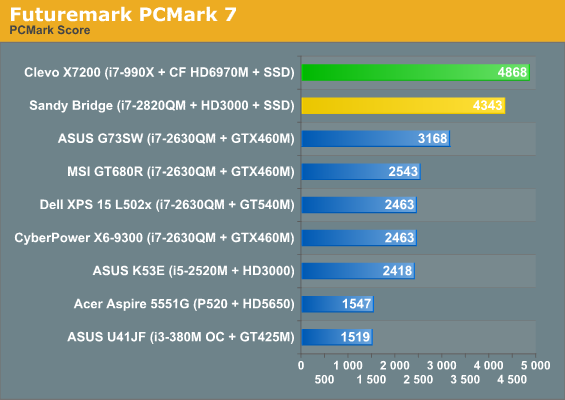
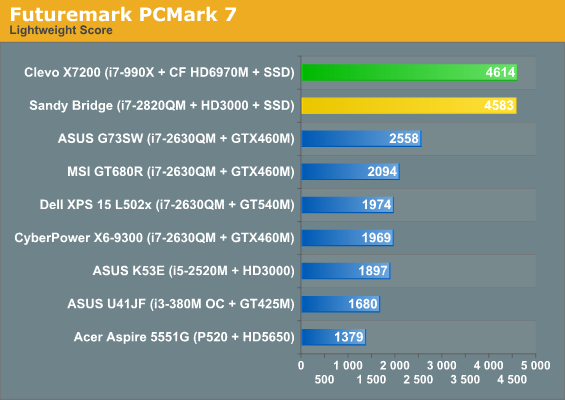
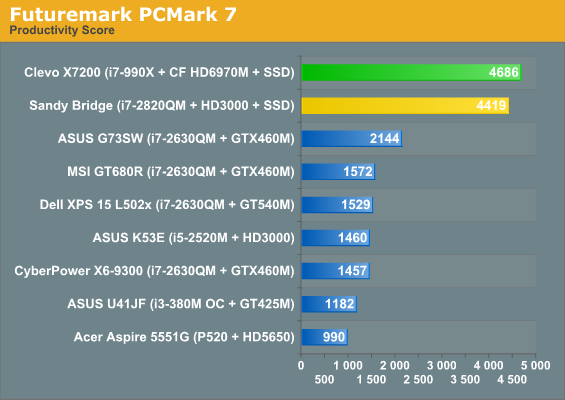
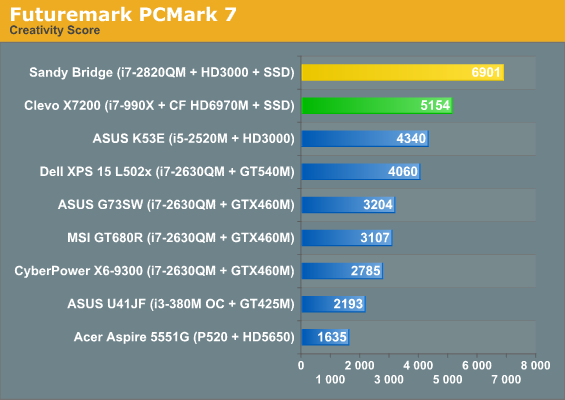
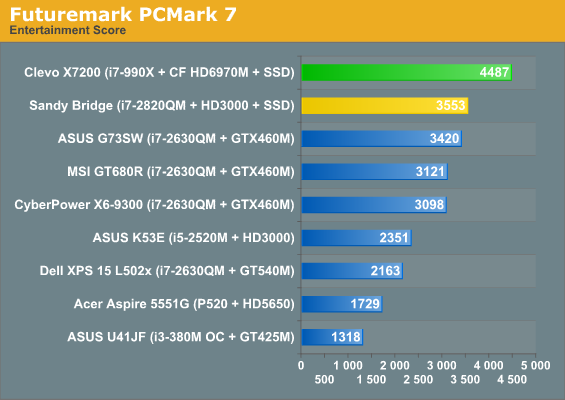
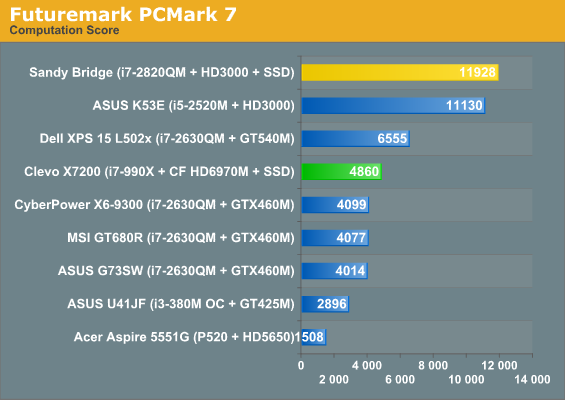

We'll start with a focus on PCMark 7, as an all-inclusive benchmark suite. We ran all of the available tests, and you can see how the focus shifts from multi-threaded to storage to GPU depending on what you're doing. Of particular interest is the Computation score, which leverages Intel's Quick Sync and thus gives the K53E and i7-2820QM a huge lead. (Strangely, the Optimus-enabled XPS 15 only seems to get partial credit for Quick Sync.) The only other test where the hex-core i7-990X fails to take the crown is in the Creativity suite, which again appears to favor the presence of Quick Sync.
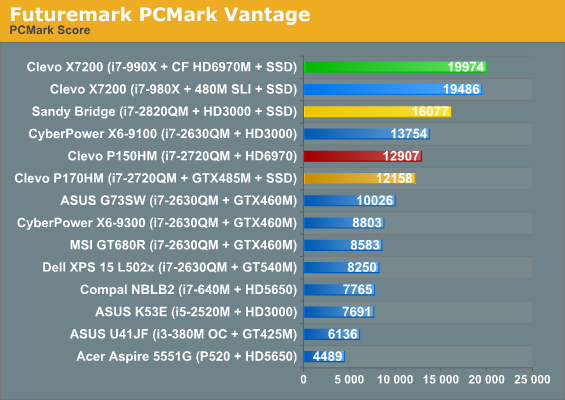
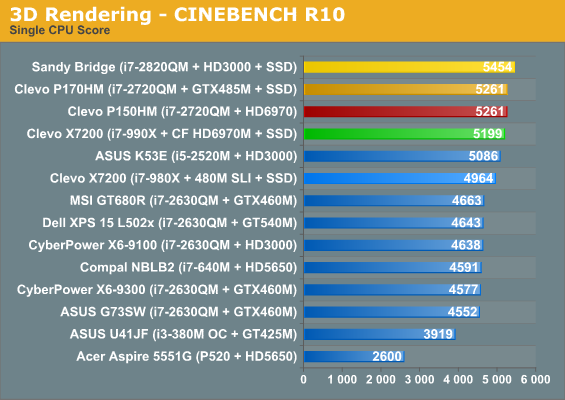

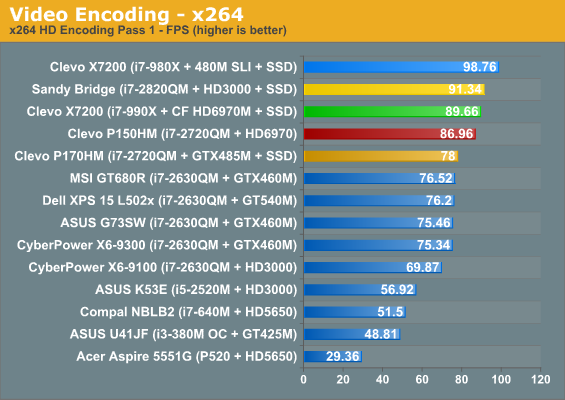
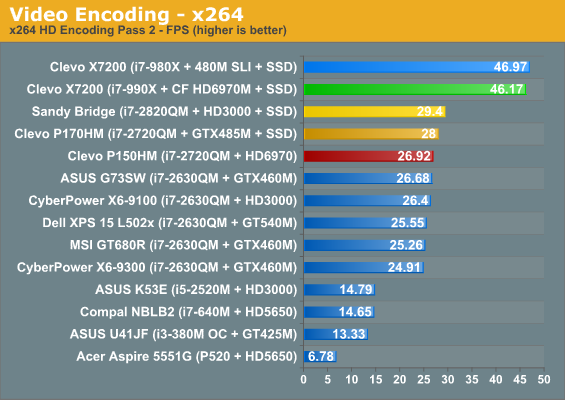
Our remaining applications fail to make use of Quick Sync, so the Gulftown CPUs return to prominence in multi-threaded workloads. The single-threaded Cinebench results are also worth pointing out, as they show the benefit of Sandy Bridge's extremely aggressive Turbo Boost states--even the dual-core SNB chips can come within striking distance of the i7-990X in such tests. In the other tests, the i7-2820QM puts in quite a show, and it will likely take Sandy Bridge E or Ivy Bridge to dethrone Gulftown for multi-threaded tasks.
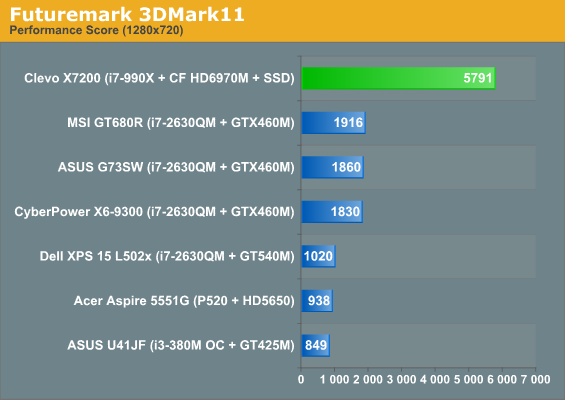
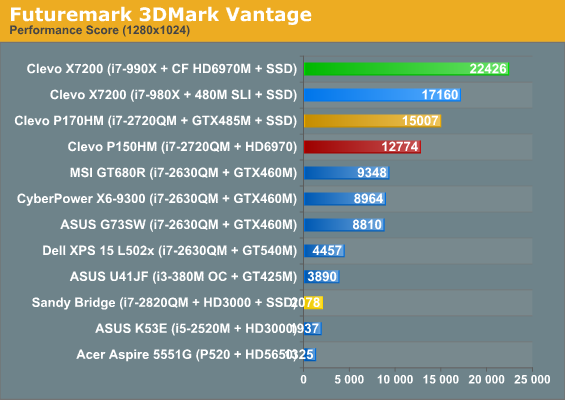
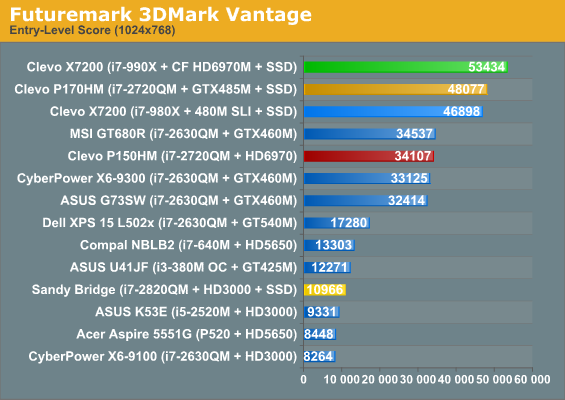
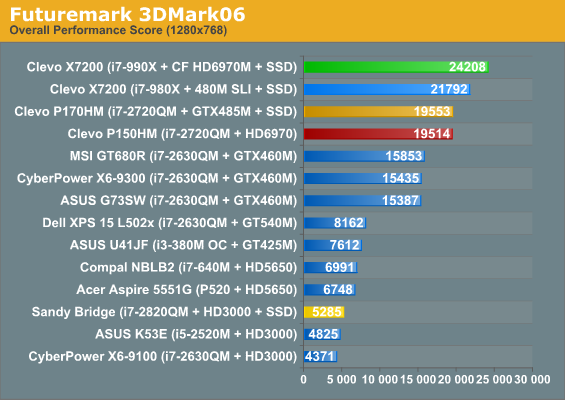
Unsurprisingly, the CrossFired Radeon HD 6970Ms thoroughly dominate in 3DMark. As the versions get newer, CrossFire also begins to scale more linearly until finally in 3DMark Vantage it practically doubles from a single 6970M. (3DMark 11 would be a similar situation, but we don't have results from the older version.) But you didn't come here to see how these ran in canned synthetic benchmarks, you want to see how they perform in real games.










44 Comments
View All Comments
patfactorx - Thursday, June 2, 2011 - link
GIVE Me thIS CASE!matty67 - Thursday, June 2, 2011 - link
There is nearly a 20% price premium on an already $4500 laptop here. I mean honestly for that additional cost it had bloody well better be faster, I'd expect it to do all kinds of other things too. A fanboy would declare the winner as the fastest card without any other consideration. A rational person would take the overall speed with a grain of salt and put it into perspective.The SLI will likely be faster but $650 faster? Odds ain't good on that one.
TrackSmart - Thursday, June 2, 2011 - link
I'm always astonished by the performance of these laptops until I look at the dimensions, weight, and price. I'm guessing the market for these things must be small (but lucrative?). I'm guessing this is for folks who regularly attend LAN parties? Even if you traveled between two homes, it would be cheaper to build two desktop computers to satisfy your gaming needs. I'm clearly not in the demographic, whatever that demographic may be...Rasterman - Friday, June 3, 2011 - link
Yeah before ordering one I didn't think it would be that big, lol it was huge, mock up a box of its size and see how big it is, its nuts, then add on to that the size of the power brick which is about half the size of a phone book, and heavier!TrackSmart - Saturday, June 4, 2011 - link
HA ha. Yeah, I think all reviews of these sorts of laptops should put them next objects of various sizes (or show the side view with a ruler next to it) to put the system size in perspective. For instance, the laptop looks about half of it's actual thickness in the main photo presented in the article...FXi - Thursday, June 2, 2011 - link
Just curious. I don't think a 485M sli would win in every situation, but you are comparing 18 month old 480 sli combo to a brand new 6970 CF and saying the 6970 takes the crown. Ok. But was it too difficult to get two of the same machine with each configuration and just test them? I mean that is what you do right, test comparable stuff to just see what happens?Guess not. Hope the AMD paycheck goes far :)
JarredWalton - Thursday, June 2, 2011 - link
AMD paid as much for our article as NVIDIA paid for your comment... actually, we might have been paid less! Anyway, it's nice to be accused of being in AMD's pocket for a change; usually it's accusations of Intel and NVIDIA paying us off, so we're apparently doing something right. :-)The truth is, getting $5000 notebooks for testing isn't that easy; AVADirect would like to have as much coverage from the various enthusiast web sites as they can get, so sending two high-end setups to one place means they get one review for the "price" of two.
We should hopefully get something with 485M SLI, but I don't expect a major difference (depending on the game). As noted in my earlier review of a single 6970M vs. a single 485M, there are cases where each side is quite a bit faster, but on average they're very close. Depending on dual-GPU scaling, either could come out ahead.
As for the title, it's more in reference to this being the fastest setup *we* have ever tested, at this point in time. If/when we test something with 485M SLI, and if it comes out on top, we'll be sure to make a note of it. Someone else already pointed out the cost vs. performance question as well: 13% higher cost for what will very likely be less than a 10% gain in performance.
FXi - Friday, June 3, 2011 - link
Well if this is was meant to say this is the fastest setup we have ever tested then why not say that? I know, you're working on that part.And I didn't say, in fact quite literally said they are pretty much neck and neck. I don't brook NV fans saying the 485's are all that nor the 6970's. AMD drivers are still out to lunch where they have to issue 5 "fix" files for every driver release they make and worse, practically no notebook maker can install drivers from the AMD website without a huge process.
But at least you said pointedly "yep we said it like we said it" and almost let it be at that. Or we could just blame AVAdirect for manipulating the market as they would sure rather sell you the stock of 6970's they have before the 580M's get to market.
Oh well, the ability to quote you as an unbiased source took a bit of a hit. You could have avoided it.
JarredWalton - Saturday, June 4, 2011 - link
Coming up with a title that says enough but isn't too long is actually quite difficult -- it's why we have the two paragraph abstract on the front page, because the title can't convey everything. If you can give me a better title that's still meaningful without getting into every detail, I'd love to hear it. I've tossed around a few ideas and I'm still not sure what would be "better". I'm not sure how it makes us any more biased than before, especially given how much I've beaten on AMD's mobile CPUs during the past several years. What we're biased towards is good hardware, and if it performs well and costs less than the competing solutions so much the better!These days, talk of drivers on either AMD or NVIDIA's side being "worse" is mostly hyperbole. AMD issues "hot fixes" for new games, especially games where CrossFire doesn't work without the hot fix. NVIDIA has beta drivers that frequently fill a similar role. My biggest complaints with AMD mobile drivers is that: 1) not all manufacturers participate in the "reference driver program" (Toshiba and Sony immediately come to mind); 2) you have to download a small utility that checks your card and then decides if you can download the driver. Ironically, if you can download the driver on a different notebook, I know that you can at least install it on Toshiba, and probably you can install it on Sony as well. So the whole process is silly and the only reason it's there is because of the OEMs -- if AMD had their druthers, they would include support for all chips (just like they used to way back in the ATI Rage 2 days).
580M (or whatever the inevitable refresh is called) will most certainly beat the 6970M, but it's not out yet. (Actually, 485M really ought to have been named 580M given the other naming changes.) More importantly, I'm still hoping someone will get back to the days of 75W mobile GPUs being the maximum, as 100W is pretty crazy for a notebook.
FXi - Saturday, June 4, 2011 - link
I honestly don't care for the 5% (which often equates to 2-5 meaningless fps) over or under. Don't care if the 580 beats or doesn't.Drivers are still bad on the AMD side. You see a lot of reviews saying it's all changed, but a year into ownership it's the same old song and dance. It's kind of says something about qualtiy control when the hotfix department issues 5 fixes in 2 weeks. And it's not like this has happened once.
On average most of the "leavers" of AMD have given some of their best products a try for a year or more and simply have found the drivers to be too painful to deal with. Is Nvidia perfect? Heck no! And they should be at the prices they charge. So don't take this as one side is pristine and one is not. But simply it's the difference between a Toyota and a Nissan. Both are good. One is simply very good.
Yep AMD is cheaper on the perf/$ equation. And that MATTERS in this economy, believe that. But after years of trying to get better, you are still getting what you pay for, and cheap is still cheap for a reason.
And yes, I've owned, tinkered, and had to deal with the worst both parties can build and they can both mess it up a lot. One could probably make an easy argument that neither one is worth the money paid for them. Would that make Intel the better choice? Maybe in a few years who knows.